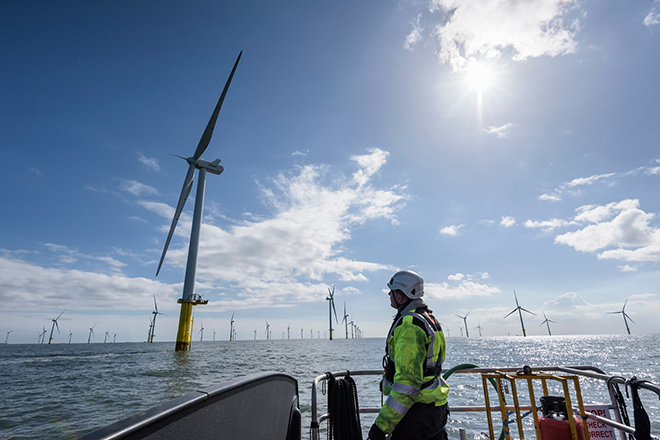
| Workers near an offshore wind farm. The sector is now breaking with a decline in prices as supply chain issues hit home. Source: Monty Rakusen/Image Source via Getty Images |
The trend of ever-falling offshore wind costs is over in light of a global supply chain squeeze, and regulators will need to think carefully about auction designs for new projects to ensure the industry remains competitive, executives said April 6 at WindEurope's annual conference in Bilbao, Spain.
"We are living in a different world right now," Martin Neubert, chief commercial officer and deputy CEO at Danish wind developer Ørsted A/S, said at the event. "Whoever thought that [levelized cost of energy] is a one-way road that just goes down, down, down — that doesn't work anymore."
The price of key commodities used in wind farms, including steel and copper, has surged in recent quarters, and equipment manufacturers have warned that costs will have to be passed on to customers.
The trend has yet to result in a change in bidding behavior in auctions, with six companies paying a total of $4.37 billion in the recent New York Bight seabed lease sale in the U.S. in exchange for the right to build projects.
"It is too expensive, and I don't think the industry can afford such prices," Álvaro Martínez Palacio, managing director for offshore wind at Iberdrola SA, said about the New York Bight auction.
In a seabed leasing round in England and Wales in 2021, winning groups similarly committed to paying hundreds of millions of pounds for project development rights, long before they even make a final investment decision.
"If we have to pay £1 billion to get our hands on a site, that's a lost opportunity and lost money that we need to [invest in] the supply chain," Neubert said.
Jan Kjaersgaard, CEO of U.S.-based General Electric Co.'s offshore wind unit, laid out the company's challenges in procuring materials for its wind turbines and said that despite ever-growing nominal capacity, scale effects will not be cushioning the blow. As gas prices and carbon prices climb, offshore wind remains competitive within the wider energy mix, Kjaersgaard noted.
"Electricity from offshore wind doesn't have to be free; it should come at a fair price," the executive said.
The marine supply chain will also place limits on scale. "You cannot buy new vessels every two years because the turbines get bigger," Kjaersgaard said.
'Exotic' players, valuable seabeds
The argument for long-term sustainability and what the wind sector sees as fair compensation sometimes collides with governments' desire to maximize the yield of their seabeds.
"[The U.K.'s] North Sea will probably be more valuable to us with wind than it was with oil and gas," Gerry Grimstone, U.K. minister for investment, said at the Bilbao event.
Governments are indeed becoming more attuned to wind as a money-maker. After seeing the outcome of the English seabed leasing round in early 2021, the Scottish government delayed its own auction, raised the maximum bid level tenfold and issued more than twice the capacity that was previously earmarked, 25 GW in total, for fixed-bottom and floating wind.
The ScotWind auction, the first in Scotland in 10 years, yielded just under £700 million in so-called option fees for the Scottish government. By capacity awarded, the round fetched much lower fees than the English one, but executives' views on the Scottish approach are divided.
"We like what we've seen in the ScotWind tender," Neubert said, referring to capped bid levels and generous capacity allocation.
Greg Gorski, COO of Ocean Winds, the joint venture between Engie SA and EDP Renováveis SA, was critical of the inflated volumes tendered and Scotland's inclusion of qualitative factors, which Gorski said are not clear enough. In that auction, several developers with no previous experience in offshore wind were awarded plots.
"There are a lot of new ... exotic players in ScotWind," Gorski said. Ocean Winds itself was successful in the auction, winning a 1-GW site, and Gorski said competition for skilled staff in the region will be fierce, given the multitude of parties involved.
"Nonprice criteria come with some risk," said Ed Northam, head of Europe and the U.K. at Macquarie Group Ltd.'s Green Investment Group Ltd. To minimize this, they ought to be transparent, realistic and measurable, Northam said.
Yet, despite all of the market turbulence, investor appetite still outpaces available projects. "We are in a crisis. ... There are contradictory signs," João Costeira, executive director for low-carbon generation at Repsol SA, said in Bilbao.
Market turbulence and higher prices have made it more risky for investors to back renewables projects than it was three years ago, the executive said. "But the business case is still there."
S&P Global Commodity Insights produces content for distribution on S&P Capital IQ Pro.



